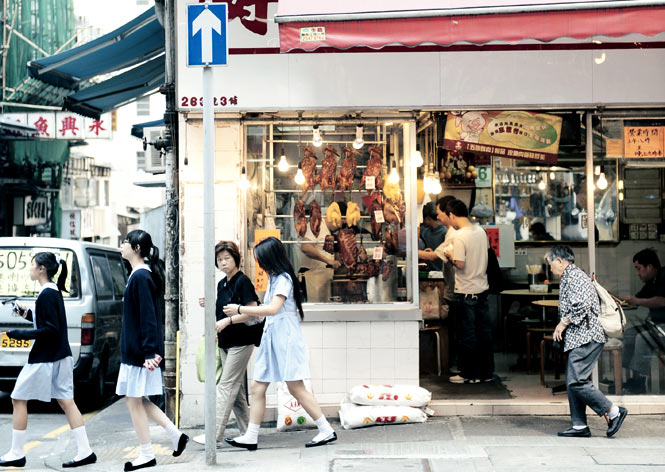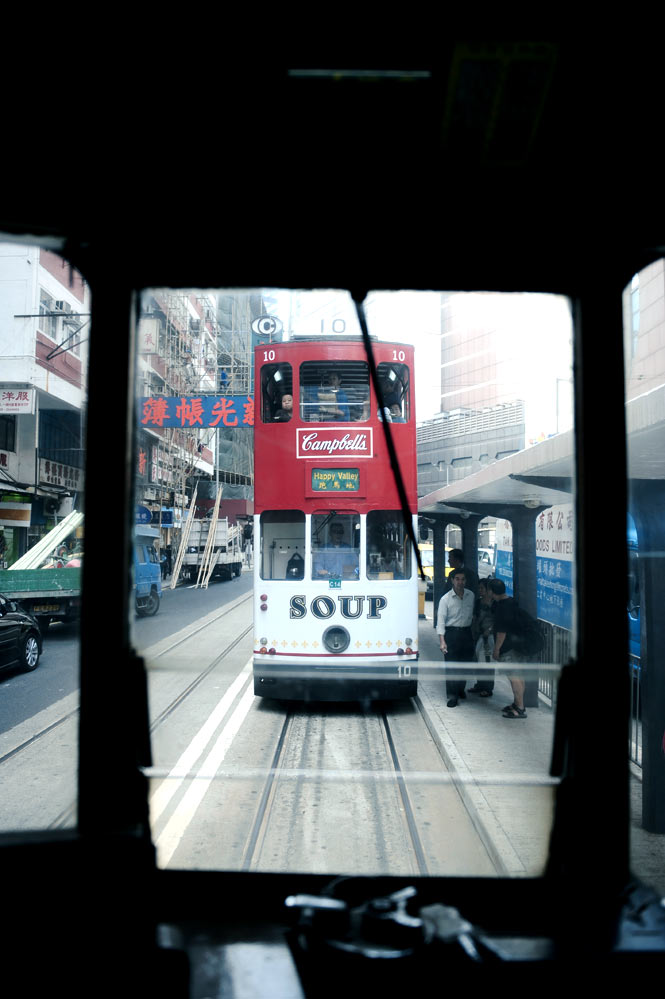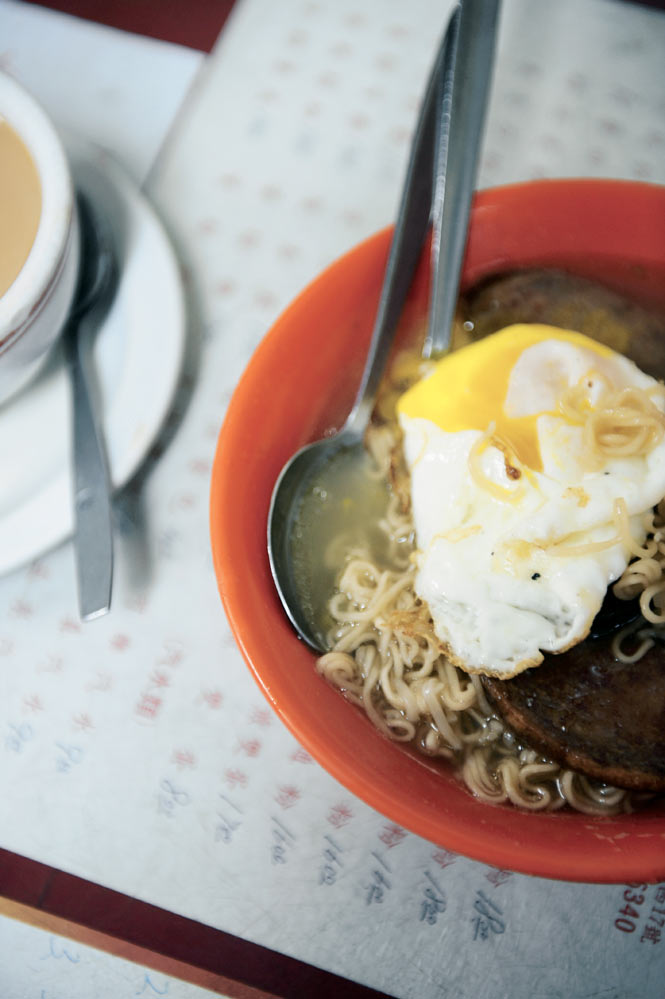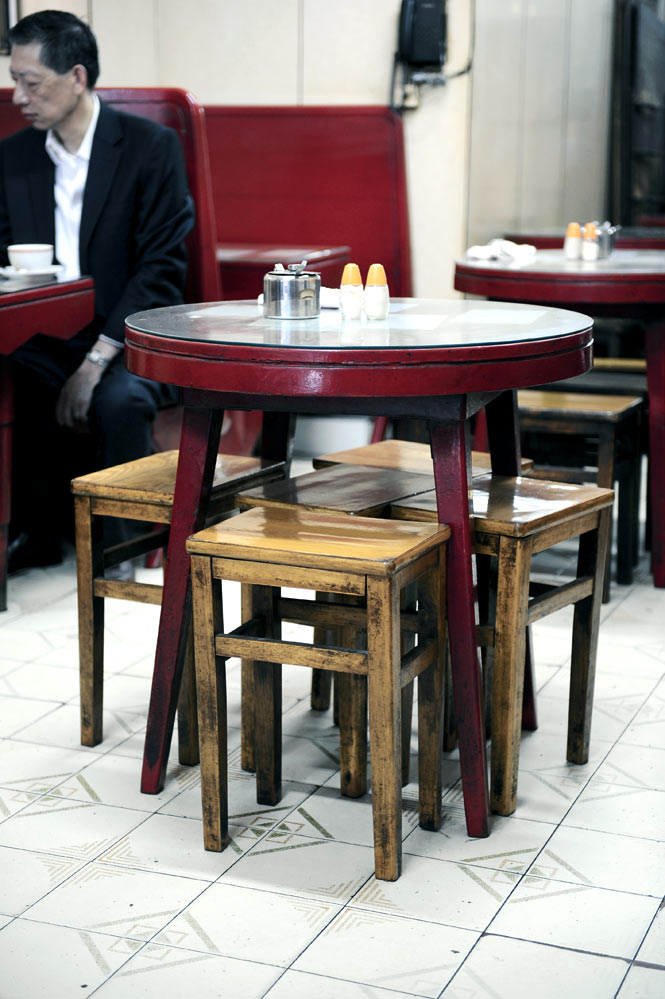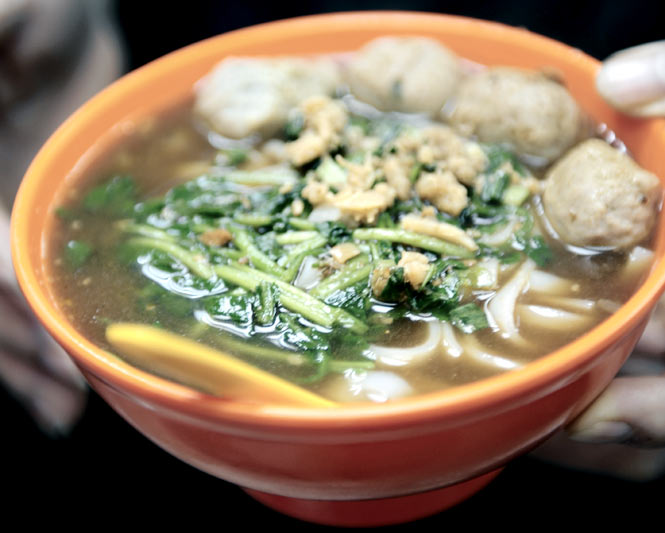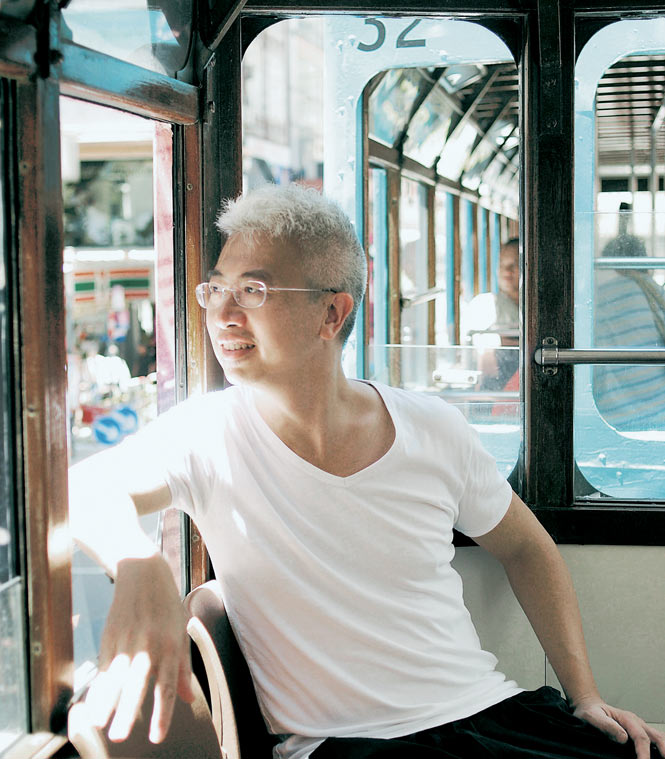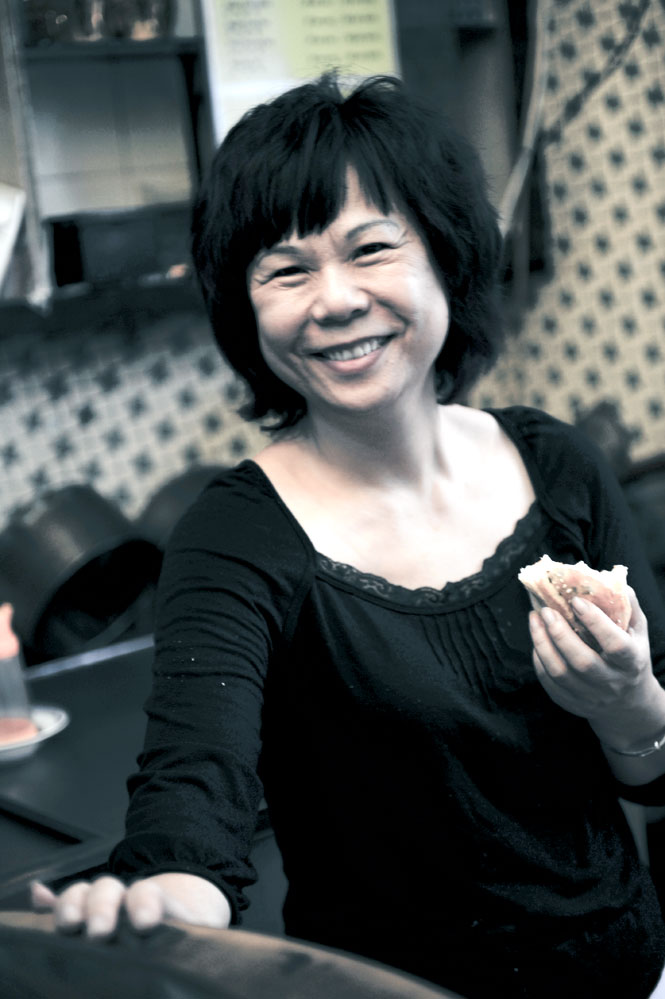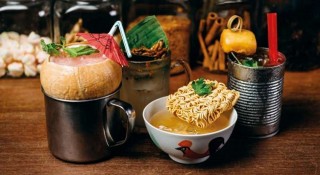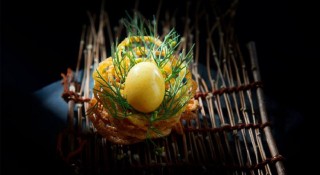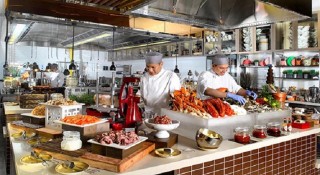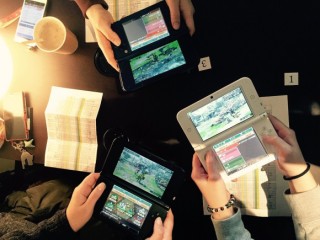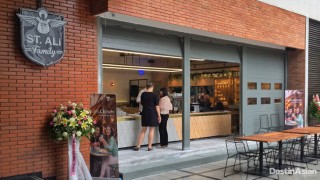Above: Outside Kwan Kee, a 16-year-old institution that is deservedly famous for its claypot rice.
Looking for a different way to delve into Hong Kong’s food scene? Try taking the tram
By Petrina Price
Photographs by Jason Michael Lang
It’s two p.m. on a muggy Hong Kong Saturday when I realize that perhaps one can have too much of a good thing. I’ve been eating continuously since morning, and the rest of the day promises more of the same. That is, if Craig has anything to do with it. A familiar figure around Hong Kong—not least for his peroxide-blond hair and trademark white T-shirt—Craig Au Yeung is taking me on a whistle-stop tour of some of his favorite backstreet eateries. But this is a culinary pilgrimage with a twist. Instead of catching cabs or riding the subway between meals, we’re using Hong Kong Island’s venerable tramway to navigate our way through town.
It all began with a custard tart, creamy and caramelly and set in a perfectly buttered shell. That was at 9 a.m. at the Hoi On Café near Kennedy Town, the western terminus of the 105-year-old streetcar line that stretches 13 kilometers across the island’s northern reach. Affectionately known as “Ding Dings” for the bell that rings as they clatter along the tracks, the double-decker trams carry an estimated 240,000 passengers every day—a mishmash of sightseers, businesspeople, school kids, and now, perhaps, foodies like me.
A social cartoonist, graphic designer, writer, and onetime TV host, Craig has his fingers in many pies, particularly the food scene. His Hong Kong Wei Dao book series explores the idiosyncrasies of local cuisine, while his cookbooks, under the banner 18 Minutes Plus, compile dozens of easy recipes inspired by market-fresh ingredients. Our breakfast rendezvous at the Hoi On Café owes itself to Craig’s latest project: documenting his favorite places to eat around the tramline for the Hong Kong Tourism Board.
“Taste is very personal, but I talked with friends and food critics to develop a list that really represents the spectrum of Hong Kong dining, from high-end restaurants to down-to-earth and homey establishments,” Craig says. His final list—some 80 eateries augmented by a handful of cultural sites—appears on a splashy new online tram guide (discoverhongkong.com/tramguide) as well as in a handy pocket guide. “The only thing the places I chose have in common, really, is that they’ve been around a while,” Craig tells me. “Many are quite nostalgic.”
That aptly describes the Hoi On Café: eating here is like turning back the calendar some 50 years. The floor tiles, warped and faded, haven’t been changed since the place opened in the mid-1900s, nor seemingly have the red lacquered furnishings or the cutlery. The recipes for the cakes and pastries churned out by the kitchen are of a similar vintage, which explains why so many customers forgo the menu and order from memory. Aside from custard tarts, the café serves classic Hong Kong baked goods:
Above, from left: Little has changed at the Hoi On Café since it opened 50 years ago; Inside the same restaurant; Ramen with pork and egg at the Hoi On Café.
piping-hot sweet buns filled with shredded coconut and sugar or topped with crispy pineapple crumble; fluffy jelly rolls and sponge cakes; and eggy slices of French toast smothered in golden syrup. Our meal here verges on gluttony, and leaves me confident that I’ve consumed a full day’s worth of calories in one sitting.
On a sugar high, we board a racing-green tram bound for Sheung Wan. It’s not far between stops, but the streetscape changes dramatically as we trundle along toward the shimmering skyscrapers of Central. After the wide, uncluttered streets of Kennedy Town, Sheung Wan—one of the oldest and densest neighborhoods on the island—appears jumbled and chaotic. We alight near Wing Lok Street and wander down alleyways lined with stalls selling dried ginseng and wild mushrooms before ducking into Kwan Kee, a hole-in-the-wall institution beloved for its Cantonese fare.
We’re here for one dish: the claypot rice, which is cooked in individual-sized earthenware pots over a coal fire. The rice isn’t seasoned until it nears al dente; then toppings—everything from eel and preserved fish to pork ribs, sausage, wind-dried duck, and chicken—are added along with a ladleful of meaty stock. Back on the coals, the dish bubbles away, and the salty juices seep through the rice to form a thick, golden crust around the rim of the pot. A rich, almost buttery aroma escapes when the lid is lifted. We dig in with chopsticks. “What I love most about Hong Kong is the vitality and variety of the food,” Craig says. “The restaurants here seem to be able to absorb different influences, but still retain their own character. Dishes like this will never change.”
We take a break from eating and walk off our second meal, scaling a steep set of stairs—one of the area’s so-called “ladder” streets—to Hollywood Road. By the time we reach Kung Lee in Central we’ve worked up a thirst. There are only two tables in this tiny sugarcane juice bar, little changed since it first opened in 1948. The green-and-white floor tiles and emerald stained-glass windows are all original, as is the antique sugarcane press, which the owner cranks in a slow, rhythmic fashion. Although the freshly squeezed juice is served without ice, it cools me down and gives me an instant energy boost. I buy a tub of sugarcane jelly on the way out the door, anticipating energy shortages later in the day.
“I eat out every night,” Craig tells me between tram stops. “Professionally, I have to try lots of different restaurants. But there are a handful of places that I always go back to.” Ser Wong Fun, which has been dishing up Cantonese comfort food for six decades, is one of them. “I’ve been coming here for a long time, and am good friends with the owner, Mrs. Ng. It’s very personal, very sentimental,” he says.
Craig’s favorite dishes begin appearing on our table before I’ve even picked up a menu. Served in a porcelain cup, the steamed egg custard with soy sauce is a silky sensation. Then there’s deep-fried chicken with fermented bean paste, double-boiled soup, and a platter of pork and duck-liver sausage. “If I’m bringing guests here for dinner, I’ll always order the fish head,” Craig says. “It’s baked in an earthenware pot together with marinated ginger and bean curd. There’s nothing else like it.”
Back aboard the tram, we roll on—ding, ding, ding!—toward Wan Chai, one of the island’s busiest commercial precincts. Just off Johnston Road, I spot shoppers bargaining over fresh fruit and vegetables at an open-air market, and hurly-burly streets fronted by raucous dim-sum parlors and petite teahouses. We take a seat in one of the latter, Yip Heung Lau, which specializes in hot and cold infusions made with gegen vines and other medicinal herbs. I’m served an inky brew that is salty, sweet, and sour all at once. Despite Craig’s assurances of its curative properties—relieving everything from vertigo and migraines to muscular disorders—I can manage only a couple of sips.
“I crave so many things whenever I’m away from Hong Kong,” Craig says as we walk to the next restaurant on his list. “I miss char siu fan [barbecue pork rice], milk tea, egg tarts, and of course congee.” As easy as it is to prepare, congee is one of those dishes that many cooks get wrong. The kitchen at King Lee, however, transforms the simple rice porridge into a delicacy. The rice is boiled with dried fish, pork bones, and bean curd for around five hours. Strips of chicken, marinated overnight in ginger, are then layered across the top along with a handful of scallions and dried garlic. The result is gooey, creamy, and pungent—perhaps not the best thing to eat in the midday heat, but delicious nonetheless.
It’s early afternoon, and time for more tarts. Craig and I hop off the tram just past the Wan Chai Playground and make our way to Spring Garden Lane. We smell Kam Fung long before we see it—the aroma of sweet and savory pastries fills the air and attracts droves of hungry lunchtime customers. I soon have my eye on a bulbous pie, stuffed with chicken and ham on a bed of scrambled eggs. It’s hot and chunky on the inside but crisp and flaky on the outside, and goes down well with a tall tumbler of iced milk tea.
No culinary tour of Hong Kong would be complete without a big bowl of noodles. We decide to go old school, and get back on the tracks en route to Wing Kee Noodles in Causeway Bay. There’s no menu at this humble diner; instead, I’m instructed to select the type of noodles I want—rice or vermicelli, instant or udon—and then a main ingredient. There’s a lot to choose from: pork skin, slivered turnip, mushrooms, fish balls, squid, beef tendon. I settle on red sausage and black mushrooms in a soup spiced with cloves, star anise, and nine other “secret” ingredients. The food arrives in a matter of minutes. Rivulets of sweat run down my back as I stick my chopsticks into the steaming bowl.
A few tram stops later, when I pause to admire the Tin Hau Temple that gives the nearby subway station its name, Craig manages to convince me that we have room for more snacks. Groaning, I follow him to Ching Ching Dessert. The black sesame and tofu puddings here are classic Hong Kong confections, as are the handmade sweet-rice dumplings stuffed with red beans and more black sesame. To take the edge off the humidity, I opt for a chilled fruit-and-sago soup. It’s light and cool, with a cream-of-almond broth that tastes like liquid marzipan.
Our final destination lies just meters from the eastern tram terminus in Shau Kei Wan. “You can get everything from little dumplings to desserts here,” Craig tells me as we approach Lui Chai Kee, a diminutive teahouse renowned for its addictive snacks. “It’s very cheap, and always crowded.” Nor has business been hurt by the fact that the proprietor, Mr. Lui, happens to be rather handsome and is much admired by the local ladies. Full as I am, I can’t resist sampling spoonfuls of Lui’s specialties: a delicate fish dumpling, sweet mixed-bean soup, and sago pudding with fresh mango and coconut milk.
“I’m easily touched by food, whether it’s molecular gastronomy or a bowl of plain congee or simple street dishes,” Craig says between mouthfuls, “but I have no time for dishes that are made without heart. Here, you can tell that a lot of love goes into the food.”
AddressBook:
Where to eat along Hong Kong’s tramway
From Kennedy Town to Shau Kei Wan, Hong Kong Island’s streetcar line gives passengers access to a diverse range of eating experiences, some of which are listed below, while many others can be found online at DiscoverHongKong.com’s easy-to-navigate Hong Kong Tram Guide. Trams operate from 6 a.m. to midnight every day, and cost HK$2 per ride (half that for children), regardless of the distance traveled.
- HOI ON CAFÉ
G/F, 17 Connaught Rd. West, Sheung Wan; 852/2540-6340 - KWAN KEE
Shop 1, Wo Yick Mansion, 263 Queen’s Rd. West, Sai Wan; 852/2803-7209 - KUNG LEE
60 Hollywood Rd., Central; 852/2544-3571 - SER WONG FUN
30 Cochrane St., Central; 852/2543-1032 - YIP HEUNG LAU
104 Johnston Rd., Wan Chai; 852/8202-7207 - KAM FUNG
41 Spring Garden Lane, Wan Chai; 852/2572-0526 - KING LEE CONGEE
146 Wan Chai Rd., Wan Chai; 852/2575-6181 - WING KEE NOODLES
27A Sugar St., Causeway Bay; 852/2808-2877 - CHING CHING DESSERT
77 Electric Rd., Tin Hau; 852/2578-6162 - LUI CHAI KEE
Shop A, 121 Shau Kei Wan Main St. East, Shau Kei Wan; 852/ 2885-8590
Originally appeared in the December 2009/January 2010 print issue of DestinAsian magazine ( “Ding Ding Dining”)

